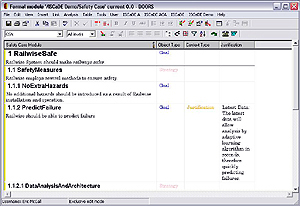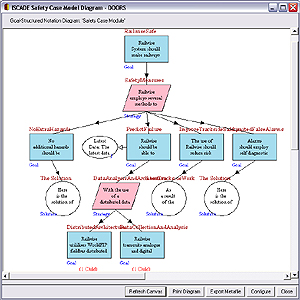
Safety Cases:
|
||||||||||||
|
||||||||||||


A safety case is a body of evidence proving as far as possible that a system, product or plant is safe for all those using it, working in it or affected by it. More specifically, it is a formal presentation of evidence, arguments and assumptions aimed at providing assurance that there are adequate safety requirements to control hazards and that these safety requirements are met. The universal need for safety compliance arose out of The Health and Safety at Work etc. Act 1974 which outlines the general duties of employers (and people in control of premises) for the health and safety of their employees and others when in or in the vicinity of their premises. The Act established the Health and Safety Executive (HSE), responsible for enforcing the legislation. Now a part of HSE, Her Majesty’s Railway Inspectorate’s role is to ensure the proper control of risks to the health and safety of employees, passengers and others who might be affected by the operation of Britain's railways. It does this, amongst other activities, by:
- ensuring through approval and inspection that new works and rolling
stock meet acceptable safety standards such as those set out in the
Inspectorate's Railway Safety Principles and Guidance and
- considering, accepting as appropriate and monitoring compliance with railway safety cases.
The UK government’s Railway Safety Case Regulations (1994, updated 2000) requires any railway infrastructure operator, or train/freight operating companies to make a case for the safety of its operations. This requirement for a safety case is then cascaded to suppliers of rolling stock, signalling and electric traction equipment for introduction of new products as well as to major rail upgrade/renewal projects.
Development of safety cases applies to other safety critical industries such as other transport modes, chemical, nuclear and defence. For more information about how ISCaDE™ Pro assists with the development and maintenance of a safety case click here to download ISCaDE™ Pro White Paper in pdf format (264KB). For a case study of the application of ISCaDE™ Pro click here to download Managing a System Safety Case in an Integrated Environment paper in pdf format (770KB), published by SEI. This module facilitates the user to build safety case diagrams. Safety has been a matter of great measure for the investors for their assets and employees. ISCaDE™ Pro provided the facility to build safety case diagrams in GSN (Goal Structured Notations).
Any one of the standard notations could be used by the user to make his safety cases. This added up in the customer’s ease and was warmly welcomed by the customers through out the world.
Safety Case Diagram Checks
The Safety Case Diagram is enriched with pre-render checks. These checks are based on certain standard and rules. All the rules are implemented in these diagrams, thus providing a great ease to user. Now there is no need to check all the standard rules manually. All this would be done automatically, when the user would select to draw the Safety Case Diagram.

Safety Case Module

GSN(Goal Structuring Notation)
A Safety Case Diagram
All rights reserved.